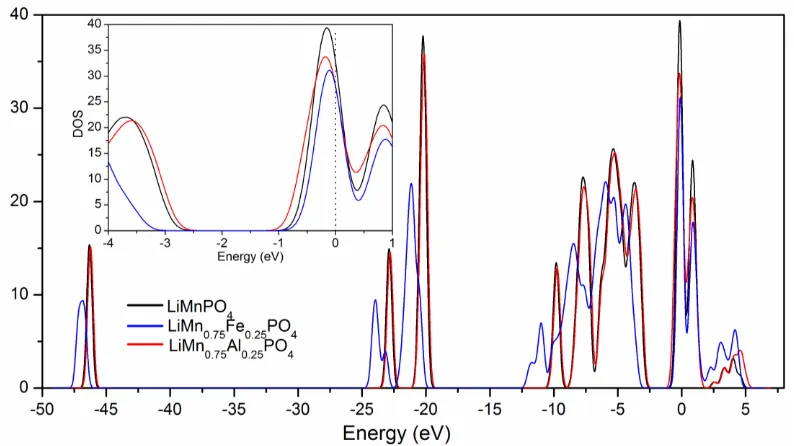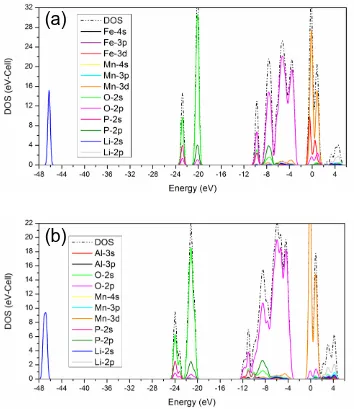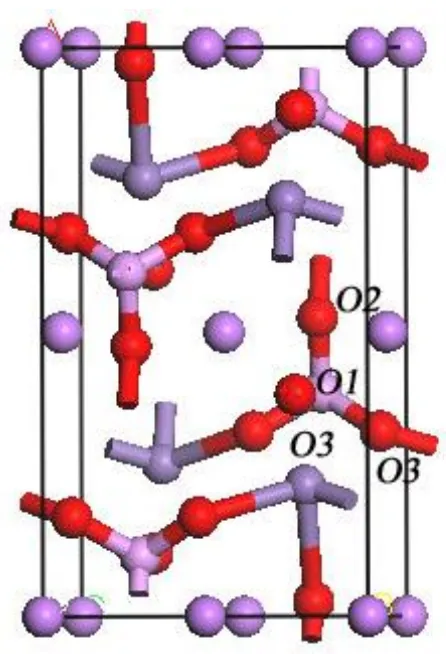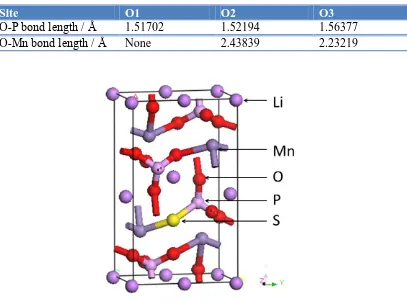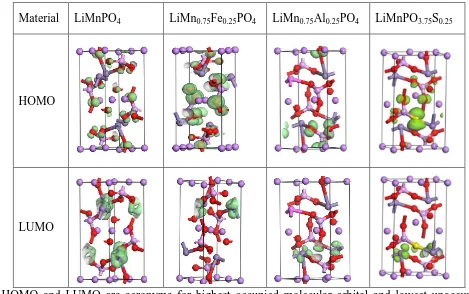Int. J. Electrochem. Sci., 7 (2012) 3362 - 3370
International Journal of
ELECTROCHEMICAL
SCIENCE
www.electrochemsci.orgFirst-Principles Study of Doping in LiMnPO
4Li Wang, Liwu Zhang, Jianjun Li, Jian Gao, Changyin Jiang, Xiangming He*
Institute of Nuclear & New Energy Technology, Tsinghua University, Beijing 100084, PR China
*
E-mail: hexm@tsinghua.edu.cn
Received: 9 February 2012 / Accepted: 17 February 2012 / Published: 1 April 2012
A density function theory (DFT) based first-principles study of doping on LiMnPO4 is attempted. The
doped LiMnPO4, such as LiMn0.75Fe0.25PO4, LiMn0.75Al0.25PO4 and LiMnPO3S at the level of electron
structure is studied. Highest occupied molecular orbital (HOMO) and lowest unoccupied molecular orbital (LUMO), density of states (DOS) and Fermi level of doped and pristine LiMnPO4 are
investigated, showing positive effectiveness for Fe and Al substitution of Mn, as well as S substitution of O, on the electronic structure of LiMnPO4 to improve its properties.
Keywords: Highest occupied molecular orbital; lowest unoccupied molecular orbital; density of states; Fermi level; LiMnPO4; doping
1. INTRODUCTION
Olivine LiMPO4 (M=Mn, Fe, Co, Ni) is highlighted as a potential cathode material owing to its
relatively high structural stability, high theoretical capacity, low cost, and environmental friendliness [1-9]. In particular, LiMnPO4 behaves similar discharge voltage to that of LiCoO2, presently the most
widely used cathode, it is anticipated that replacement of the cathode with this material can be accomplished without major difficulties at the battery system level. And also, its thermal stability is proved to be relatively higher than α-NaFeO2 structure cathode material.[10] However, its sluggish
13,14] A theoretical cognition and further prognosis is essential to smart structure and synthesis design.
Here report a density function theory (DFT) based first-principles study of several doped LiMnPO4, including LiMn0.75Fe0.25PO4, LiMn0.75Al0.25PO4, LiMnPO4 and LiMnPO3S at the level of
electron structure. Though the electronic structure of materials calculated by LDA+GGA is far from the actual, due to the very approximate treatment of the electron correlation in transition metal orbital, the relative variation among different doped materials and the pristine still make sense. The correlation among composition, electronic structure, chemical bond, and property has been studied.
2. COMPUTATIONAL METHODS
The first-principles study is performed using Materials Studio 4.1 software package. Generalized gradient approximation (GGA) was employed to investigate the electronic structure of pristine LiMnPO4 and the doped. In particular, exchange-correlation effects were taken into account by
using the generalized gradient approximation (GGA). The total energy code CASTEP was used, which utilizes pseudo-potentials to describe electron ion interactions and represents electronic wavefunctions using a plane-wave basis set. In calculations shown, an energy cut-off of 500 eV and appropriate k-point of 5×5×5 were chosen so that the total ground state energy is converged to within 1 meV per formula unit. The correlation among composition, electronic structure, chemical bond, and property has been studied.
3. RESULTS AND DISCUSSION
3.1 Cation doping
Here Fe and Al are chosen as typical doping to investigate the effect of cation on electron structure of LiMnPO4. On one hand, LiMn1-xFexPO4 is reported to exhibit better electrochemical
performance than pure LiFePO4. On the other hand, It is reported that Al-doping can enhance the ion conductivity of LiFePO4 due to donor effect, [18] while decrease electronic conductivity in accordance
with a p-type mechanism [19]. Since Al-doping is generally effective to improve the thermal stability of the virgin material, it is worthy of verifying the role of Al on the electron structure of LiMnPO4. Fe
tends to preferably take the substitution of Mn, due to its similarities with Mn. For Al ion, though it is far smaller than Mn ion, theoretical investigation shows that it dose not show a preference for the Li site [20]. The models for calculations are as shown in Fig.1. As CASTEP model only suitable for systems of tens of atoms, the doping content is fixed as M:Mn=1:3 in this study. For just to get a roughly comprehension on doping effect, charge compensation is not considered for the aliovalent substitution.
Fig. 2 shows the calculated density of states (DOS) for LiMnPO4, LiMn0.75Fe0.25PO4 and
LiMn0.75Fe0.25PO4 and LiMn0.75Al0.25PO4, respectively, is indicative of semiconductor structures for
[image:3.596.151.439.110.342.2]these three materials.
Figure 1. Cell model for cation doped LiMnPO4. 28 atoms are evolved in this model.
Figure 2. Comparison of total density of states of LiMnPO4, LiMn0.75Fe0.25PO4, and
LiMn0.75Al0.25PO4. The insert is a local amplification.
[image:3.596.101.498.401.624.2]
for every material can be divided into three segments. Comparing with those of LiMnPO4, the
segments of LiMn0.75Fe0.25PO4 present roughly the same width but a small difference in location and
intensity, while the segments of LiMn0.75Al0.25PO4 are much wider and shift to lower energy. In
particular, the difference in intensity between valence band and conduction band is smaller for LiMn0.75Fe0.25PO4 than for LiMnPO4, revealing the improved electric conductivity by Fe doping. This
result confirms that Fe doping not lead great change on bonding structure, however Al doping causes dramatic changes not only on the bonds between metal atoms and oxygen atoms, but also strong covalently bonded PO4 tetrahedron.
(a)
(b)
Figure 3. Total DOS and partial DOS of (a) LiMn0.75Fe0.25PO4, and (b) LiMn0.75Al0.25PO4.The Fermi
level is set at zero energy.
Partial DOS of every element shows different contributions to the total DOS. The comparison of total DOS and partial DOS for LiMn0.75Fe0.25PO4 and LiMn0.75Al0.25PO4 is showed in Fig. 3(a) and
[image:4.596.122.476.234.643.2]
and Mn3d mainly contributes to conduction band, while others are far from Fermi level. Fe3d present
obvious contribution of conduction band, while Al contributes little to neither valance and conduction band. In fact, calculations for LiFePO4 based on other models leads to similar conclusions [18, 20],
suggesting that aliovalent dopant substitution in LiMPO4 is unlikely [15-17] and that any enhancement
in electronic conductivity may not be a true lattice doping effect. Besides, correlation among atoms can be judged from resonance phenomena.
[image:5.596.185.408.223.550.2]3.2 Anion doping
Figure 4. Analysis of O site in LiMnPO4
As a polyanion compound, Mn-O bonds are strong interfered by P atoms via strong interactions like Mn-O-P. So any variations happening on (PO4)3- will in turn affect the Mn-O bonds [21, 22]. In
this sense, anion substitution can also affect the electron distribution of the base material very much. As showed in Fig. 4, O2p contributes to the top of valance band, so substitution of O atoms with less
electronegative atom, such as S, may be benefit for the electronic conductivity. However, anion substitution is less often attempted both theoretically and experimentally. Sulfur substitution at oxygen site in oxides semi-conductors has been proved to be effective, similar attempt in LiMnPO4 however
has never been reported. As reported, the four O atoms in LiMnPO4 in fact can be divided into three
different O atoms are listed in table 1, which may help us predict the stability of O atoms. Since O-P bond is much stronger than O-Mn bond, so O3 is relatively more chemically active and easy to be substituted. Base on above discussion, the cell model for LiMnPO3.75S0.25 is determined and presented
[image:6.596.96.503.189.491.2]in Fig. 5.
Table 1. Calculated bond length of different O atoms
Site O1 O2 O3
O-P bond length / Å 1.51702 1.52194 1.56377
O-Mn bond length / Å None 2.43839 2.23219
Figure 5. Cell model for LiMnPO3.75S0.25. 28 atoms are evolved in this model.
Figure 6. Total DOS and PDOS of LiMnPO3.75S0.25.The Fermi level is set at zero energy. The insert
[image:6.596.196.400.218.487.2] [image:6.596.137.462.541.718.2]
Fig. 6 shows the total DOS and partial DOS of LiMnPO3.75S0.25. The contribution of Li, O, P
and Mn to the total DOS for LiMnPO3.75S0.25 is similar to that of LiMnPO4. For example, the partial
DOS of Mn around Fermi level shows the splitting of Mn 3d clearly, and Mn3d partial DOS mainly
contributes to the lowest conduction band, O2p mainly contributes to the highest valence band near to
the Fermi level, while the other partial DOSs are further away from the Fermi Level. It is noticeable that S3p presents a visible contribution to highest valence band, revealing that S doping may improve
the electric conductivity of the host material. Besides, the band gap of LiMnPO3.75S0.25 is smaller than
that of LiMnPO4, indicating also that S substitution of O is helpful for improving of electric
[image:7.596.59.528.276.570.2]conductivity.
Table 2. Compare of HOMO and LUMO of doped and pristine LiMnPO4
Material LiMnPO4 LiMn0.75Fe0.25PO4 LiMn0.75Al0.25PO4 LiMnPO3.75S0.25
HOMO
LUMO
* HOMO and LUMO are acronyms for highest occupied molecular orbital and lowest unoccupied molecular orbital, respectively.
A visual comparison of HOMO and LUMO for the doped and pristine LiMnPO4 is shown
Table 2. It is interesting that both HOMO and LUMO changed greatly after doping. Fe doping makes LUMO focus only around Fe atoms, and the shape of LUMO is similar to that of LiMnPO4. Also, the
distribution of HOMO changes by Fe doping. As can be observed, O atoms near Li atoms show bigger HOMO distribution than those in LiMnPO4. However, Al doping not only makes LUMO focus only
around Mn atoms, but also causes disappearance of HOMO from O atoms those are near Li atoms. This may imply that Fe doping is helpful for electronic conductivity, while Al doping may be helpful for transference of Li ion. In addition, LUMO distribution in LiMn0.75Al0.25PO4 looks more localized
electric conductivity. For LiMnPO3.75S0.25, the contribution of S doping on valence band can be
identified very clear. HOMO in LiMnPO3.75S0.25 is more delocalized than that in LiMnPO4. Though the
case is on the contrary for LOMO, S doping may be still positive to electric conductivity, due to the well match between HOMO and LOMO.
4. CONCLUSION
Fe and Al substitution of Mn, as well as S substitution of O, on the electronic structure of LiMnPO4 are studied. The results account for positive effect of Fe doping and S doping to the
enhancement of electric conductivity. Though Al doping is not favorable for increase of electric conductivity, it may benefit lithium ion diffusion.
ACKNOWLEDGEMENT
This work is supported by the Ministry of Science and Technology (Grant No. 2011CB935902 and Grant No. 2010DFA72760), the National Natural Science Foundation of China (Grand No.20901046 and Grand No.20903061) and the Tsinghua University Initiative Scientific Research Program (Grand No. 2010THZ08116, No.2011THZ08139 and No.2011THZ01004).
References
1. C. Delacourt, L. Laffont, R. Bouchet, C. Wurm, J.B. Leriche, M. Morcrette, J.M. Tarascon, C. Masquelier, J. Electrochem. Soc., 152(2005) A913-A921.
2. D. Bhuvaneswari, Gangulibabu, Chil-Hoon Doh, N. Kalaiselvi, Int. J. Electrochem. Sci., 6(2011)3714-3728.
3. D.Y. Wang, H. Buqa, M.l Crouzet, G. Deghenghi, T. Drezen, I. Exnar, N.H. Kwon, J.H. Miners, L. Poletto, M. Gräzela, J. Power Sources, 189(2009) 624–628.
4. H.C. Wong, J. R. Carey, J.S. Chen, Int. J. Electrochem. Sci., 5(2010)1090-1102.
5. C.L. Hu, H.H. Yi, H.S. Fang, B. Yang, Y.C. Yao, W.H.i Ma, Y.N. Dai, Int. J. Electrochem. Sci., 5(2010)1457-1463.
6. Gangulibabu, N. Kalaiselvi, D. Bhuvaneswari, C. H. Doh, Int. J. Electrochem. Sci., 5(2010)1597-1604.
7. C. Delacourt, P. Poizot, M. Morcrette, J. M. Tarascon, C. Masquelier, Chem. Mater. 16 (2004) 93-99.
8. H.H Yi, C.L. Hu, H.H. Fang, B. Yang, Y.C. Yao, W.H Ma, Y.N. Dai. Int. J. Electrochem. Sci., 7(2012)663-670.
9. L. Wang, W. T. Sun, X. M. He, J. J. Li, C. Y. Jiang, Int. J. Electrochem. Sci. 6 (2011) 2022-2030. 10. D. Choi, Jie Xiao, Y. J. Choi, J. S. Hardy, M. Vijayakumar, M. S. Bhuvaneswari, J. Liu, W. Xu,
W. Wang, Z.G. Yang, G. L. Graff, J.G. Zhang, Energy Environ. Sci., 4(2011) 4560-4566 11. T. Shiratsuchi, S. Okada, T. Doi, J. Yamaki, Electrochim. Acta, 54 (2009) 3145-3151. 12. D.H. Baek, J.K. Kim, Y.J. Shin, G. S. Chauhan, J.H. Ahn, K.W. Kim, J. Power Sources, 189
(2009) 59-65.
13. G.Y. Chen, J.D. Wilcox, T. J. Richardson, Electrochem. Solid-State Lett., 11(2008) A190-A194. 14. Y.C. Chen, J.M. Chen, C.H. Hsu, J.W. Yeh, H.C. Shih, Y.S. Chang, H.S. Sheu, J. Power Sources,
15. Ravet, N.; Abouimrane, A.; Armand, M. Nat. Mater., 2(2003) 702-703.
16. Delacourt, C.; Poizot, P.; Tarascon, J.M.; Masquelier, C. Nat. Mater., 4(2005) 254-259. 17. Herle, P. S.; Ellis, B.; Coombs, N.; Nazar, L. F. Nat. Mater., 3(2004) 147-152.
18. R. Amin, C.T. Lin, J, Maier, Phys. Chem. Chem. Phys., 10(2008) 3519-3523.
19. J. Molenda, W. Ojczyk, K. Swierczek, W. Zajac, F. Krok, J. Dygas, R.S. Liu, Solid State Ionics, 177(2006) 2617-2624.
20. M.S. Islam, D.J. Driscoll, C.A.J. Fisher, P.R. Slater, Chem. Mater., 17(2005) 5085-5092. 21. J. Goodenough, K. Padhi, J. Electrochem. Soc., 144(1997) 1188-1194.
22. A.K. Padhi, K.S. Nanjundawamy, J.B.Goodenough, J. Electrochem. Soc., 144(1997) 1609-1613.
